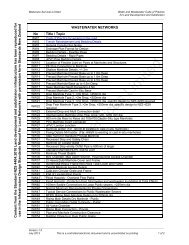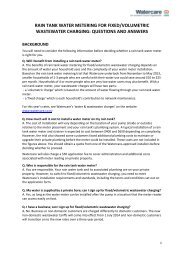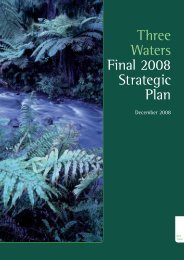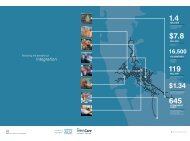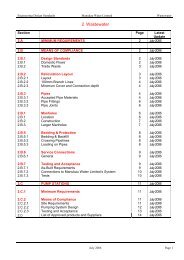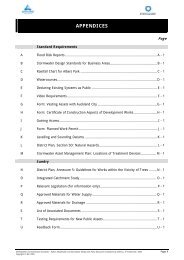Annual Report 2011 - Watercare
Annual Report 2011 - Watercare
Annual Report 2011 - Watercare
You also want an ePaper? Increase the reach of your titles
YUMPU automatically turns print PDFs into web optimized ePapers that Google loves.
<strong>Watercare</strong> Services Limited<br />
<strong>2011</strong> ANNUAL REPORT<br />
STATEMENT OF ACCOUNTING POLICIES (continued)<br />
FOR THE YEAR ENDED 30 JUNE <strong>2011</strong><br />
15. Provisions<br />
The group provides for the cost of employees’ entitlements to annual leave, sick leave and gratuities under the terms of their employment<br />
contracts. These amounts are expected to be settled within one year and are therefore recorded in current provisions.<br />
The group provides for the liability for employees’ long service leave under the terms of their employment contracts. The liability is calculated<br />
as the present value of the expected future payments after allowing for wage and salary increases, the rate of staff turnover and term of service<br />
with the group. Long service leave is recorded in current and non-current provisions. The amount recorded in non-current provisions represents<br />
the portion which is due for payment beyond one year from the reporting date.<br />
Other provisions are recognised when the group has a present obligation as a result of a past event and it is probable that there is a future<br />
outflow of resources and the amount of the provision can be reliably measured.<br />
The amount recorded as a provision is the best estimate of the consideration required to settle the obligation at the end of each year.<br />
16. Contract Retentions<br />
Certain construction contracts entitle the group to retain specified amounts to ensure the performance of contract obligations. These retentions<br />
are recorded as a liability, and either used to remedy contract performance or paid to the contractor at the end of the retention period.<br />
17. Foreign Currencies<br />
The cost of assets purchased with foreign currencies is calculated using the exchange rate on the date of purchase. Any difference between<br />
this cost and the amount later required to settle the transaction is recognised as a foreign exchange gain or loss.<br />
Operating expenses in foreign currencies are converted at the rate of exchange on the date of the transaction.<br />
18. Financial Instruments<br />
A financial instrument is any contract that gives rise to a financial asset of one entity and a financial liability or equity instrument in another.<br />
As such, the group recognises all its financial instruments as soon as it becomes a party to the contractual provisions of the financial instrument.<br />
At each reporting date the group includes in its statement of financial position a range of financial assets that include cash and short-term<br />
deposits, trade and other receivables, and derivative instruments. Similarly it also reflects in its statement of financial position a number of<br />
financial liabilities that include bank overdrafts, trade and other payables, borrowings and derivative instruments.<br />
A derivative is a financial instrument or other contract that satisfies all of the following characteristics: its value changes in response to the change<br />
in a specified variable such as an interest rate, financial instrument price, commodity price, foreign exchange rate, index of prices or rates, credit<br />
rating or credit index; it requires no initial investment or an initial investment that is smaller than would be required for other types of similar<br />
contracts and it will be settled at some future date.<br />
Sourcing fair values<br />
For financial instruments that are traded in active markets, quoted market prices are used as a measure of fair value. Where quoted market prices<br />
do not exist, fair values are estimated using present value or other market-accepted valuation techniques, using methods and assumptions that<br />
are based on market conditions and risks existing at balance date.<br />
Recognition and measurement of financial assets<br />
Financial assets are initially measured at fair value and for the purpose of subsequent measurement, the group has categorised financial assets<br />
into the following categories. Each category determines the process of subsequent measurement and how the resulting surplus or deficit should<br />
be reflected in the statement of comprehensive income. The group does not currently have financial assets in the held to maturity and availablefor-sale<br />
categories.<br />
<strong>2011</strong> Financial <strong>Report</strong><br />
Loans and receivables<br />
The group’s cash and cash equivalents and trade and other receivables fall into this category of financial instruments. These are initially recorded<br />
at their fair value plus transaction costs because they have fixed or determinable payments that are not quoted in an active market. Fair value is<br />
estimated as the present value of future cash flows.<br />
After initial recognition, they are recorded at amortised cost using the effective interest method, less provision for impairment. The amount of<br />
impairment loss is the difference between the assets’ carrying amount and the present value of estimated future cash flows, discounted at the<br />
original effective interest rate. The amount of the impairment loss is recognised in determining the surplus or deficit for the year.<br />
The collection of trade receivables is reviewed on an ongoing basis and debts known to be uncollectible are written off. When there is objective<br />
evidence that the group will not be able to collect all amounts due according to the original terms of the receivables, a provision is made for<br />
doubtful receivables to recognise an impairment in the carrying value of receivables at balance date. This amount provided is recorded in<br />
determining surplus or deficit.<br />
PAGE 78<br />
Return to Contents page





